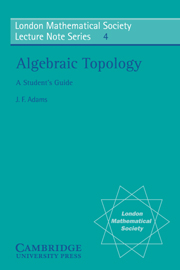Book contents
- Frontmatter
- Contents
- INTRODUCTION
- PAPERS ON ALGEBRAIC TOPOLOGY
- 1 Combinatorial homotopy
- 2 An axiomatic approach to homology theory
- 3 La suite spectrale. 1: Construction générale
- 4 Exact couples in algebraic topology
- 5 The cohomology of classifying spaces of H-spaces
- 6 Cohomologie modulo 2 des complexes d'Eilenberg-MacLane
- 7 On the triad connectivity theorem
- 8 On the Freudenthal theorems
- 9 The suspension triad of a sphere
- 10 On the construction FK
- 11 On Chern characters and the structure of the unitary group
- 12 Espaces fibrés et groupes d'homotopie. I, II
- 13 Generalised homology and cohomology theories
- 14 Relations between ordinary and extraordinary homology
- 15 On axiomatic homology theory
- 16 Characters and cohomology of finite groups
- 17 Extract from thesis
- 18 Relations between cohomology theories
- 19 Vector bundles and homogeneous spaces
- 20 Lectures on K-theory
- 21 Vector fields on spheres
- 22 On the groups J(X). IV
- 23 Summary on complex cobordism
1 - Combinatorial homotopy
Published online by Cambridge University Press: 23 May 2010
- Frontmatter
- Contents
- INTRODUCTION
- PAPERS ON ALGEBRAIC TOPOLOGY
- 1 Combinatorial homotopy
- 2 An axiomatic approach to homology theory
- 3 La suite spectrale. 1: Construction générale
- 4 Exact couples in algebraic topology
- 5 The cohomology of classifying spaces of H-spaces
- 6 Cohomologie modulo 2 des complexes d'Eilenberg-MacLane
- 7 On the triad connectivity theorem
- 8 On the Freudenthal theorems
- 9 The suspension triad of a sphere
- 10 On the construction FK
- 11 On Chern characters and the structure of the unitary group
- 12 Espaces fibrés et groupes d'homotopie. I, II
- 13 Generalised homology and cohomology theories
- 14 Relations between ordinary and extraordinary homology
- 15 On axiomatic homology theory
- 16 Characters and cohomology of finite groups
- 17 Extract from thesis
- 18 Relations between cohomology theories
- 19 Vector bundles and homogeneous spaces
- 20 Lectures on K-theory
- 21 Vector fields on spheres
- 22 On the groups J(X). IV
- 23 Summary on complex cobordism
Summary
The first extract is from J. H. C. Whitehead1 s fundamental paper on CW-complexes, which are a most useful class of spaces in which to do homotopy theory. There is always an analogy between what we can do topologically with a space, and what we can do algebraically with its chain groups, etc.; in this class of spaces the analogy reaches its maximum strength. The main prerequisite for reading this extract is a sound knowledge of general topology. On p. 40 Whitehead also uses the homotopy extension property for the pair En, Sn−1. Whitehead also makes two references to his earlier papers; the first, on p. 40, is to a geometrical construction which the reader can supply for himself; the second, on p. 42, is to the subdivision argument referred to in §1 above. At the foot of p. 41 Whitehead uses the word ‘cellular’; a map f:X → Y between CW-complexes is said to be cellular if f(Xn) ⊂ Yn for each n, where Xn is as defined on p. 33.
4. Cell complexes.16 By a cell complex, K, or simply a complex, we mean a Hausdorff space, which is the union of disjoint (open) cells, to be denoted by e, en, eni, etc., subject to the following condition. The closure, ēn of each n-cell, en∈X, shall be the image of a fixed n-simplex, σn, in a map, f:σn→ ēn, such that
(4.1) (a) f|σn−∂σn is a homeomorphism onto en,
(b)where ∂en=f∂σn = ēn−enand Kn−1is the (n−1)- section of K, consisting of all the cells whose dimensionalities do not exceed n − 1.
- Type
- Chapter
- Information
- Algebraic TopologyA Student's Guide, pp. 32 - 45Publisher: Cambridge University PressPrint publication year: 1972



